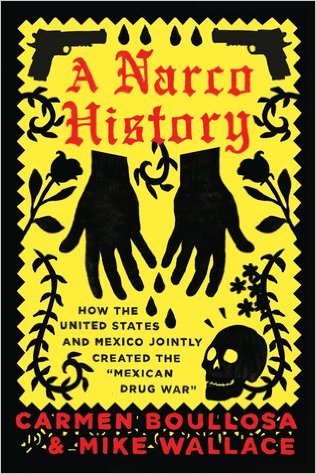 It takes a strong stomach to wade through the relentless parade of horror that is A Narco History. But if you really want to grasp "How the United States and Mexico Jointly Created the 'Mexican Drug War'," as the subtitle promises—this is the book to read...
It takes a strong stomach to wade through the relentless parade of horror that is A Narco History. But if you really want to grasp "How the United States and Mexico Jointly Created the 'Mexican Drug War'," as the subtitle promises—this is the book to read...
Co-authors Carmen Boullosa and Mike Wallace open with a chillingly detailed depiction of the grisly end met by 43 student protesters in Guerrero state, who were in September 2014 abducted by police and turned over to a mass-murdering narco-gang. What authorities believe to be their burnt remains were left in garbage bags at the bottom of a canyon.
After this wake-up call to the gravity of the crisis, they chronicle the mess from its origins a century ago, when Mexico adopted the prohibitionist model in the wake of the 1910-7 Revolution—and turned the screw ever tighter under US pressure, going all the way back to the days of Harry Anslinger in the '30s. But the rise of the narco-economy in the 1970s was actually overseen by the state—particularly, the Federal Security Directorate (DFS), Mexico's answer to the CIA. This agency became the protector of the Guadalajara Cartel, the country’s first narco-syndicate. DFS chief Miguel Nazar Haro, charged precisely with cracking down on the narco trade, was really the country's reigning drug lord.
Since then, there has been a cycle of splintering and reconsolidation in the narco industry—with the splintering occasioned by greater violence each time the spiral comes ‘round. The DFS-Guadalajara nexus was broken when the cartel went too far and had DEA agent Kiki Camarena tortured to death in 1985 in retaliation for the bust a giant marijuana plantation. The next reconsolidation happened at an Acapulco summit of narco-jefes in 1989—said to have been overseen by a high-ranking commander of the Judicial Police who (of course) had been assigned to crack down on the narco-networks. This spawned a new alliance in the west of the country under the Sinaloa Cartel. This alliance, with increasing collusion of the authorities, subsequently went to war with the Juárez Cartel and Gulf Cartel, which respectively dominated the center and east of Mexico's North..
The Gulf Cartel formed a paramilitary wing, Los Zetas—overseen (surprise!) by ex-commanders of elite army anti-narco forces who had been trained by the Pentagon at Fort Benning. The Zetas also availed themselves of freelance training from Guatemala’s notoriously bloodthirsty elite unit, the Kaibiles. At a 2001 summit in Cuernavaca, the Sinaloa-led alliance bonded more formally as the "Federation." This formed its own paramilitary force to counter the Zetas—Los Negros, which recruited from the ultra-violent Mara Salvatrucha network that linked the barrios of Los Angeles and San Salvador. The stage was set for the gangland wars to morph into a real war, by any definition.
The level of violence shot way up after 2006, when President Felipe Calderón sent the army into the streets to deal with the warring gangs. This precipitated another period of splintering. In 2010, the Zetas broke from the Gulf Cartel and went to war on their former masters for control of eastern Tamaulipas state. The Federation likewise fractured, and bloody regional struggles emerged over Michoacán and other western states. A 2014 summit in the border town of Piedras Negras brought together several anti-Sinaloa factions to discuss a sort of counter-federation led by the Zetas—the most spectacularly violent outfit in a very competitive field.
NAFTA played its role, impoverishing campesinos who lost protected markets for their legal crops and were forced to swell the ranks of the cartels. The narco industry is today second only to oil among Mexico’s economic sectors. The death toll over the past decade may be higher than 70,000. Perhaps a fourth of the armed forces have defected to the Zetas and other cartel forces, and there are fears that Mexico may soon be a "failed state."
The authors take heart at the end from activist upsurges against the militarized model both sides of the border. Given how deeply Mexico's government is coopted by the cartels, it rings a little naive when they express hopes for a "new nexus of state and civil society." The challenge remains to bring together movements for human rights and against police abuse with those for a more humane and tolerant drug policy.







Recent comments
2 days 4 hours ago
1 week 1 day ago
5 weeks 1 day ago
9 weeks 4 hours ago
13 weeks 9 hours ago
13 weeks 5 days ago
23 weeks 5 days ago
27 weeks 6 days ago
28 weeks 6 days ago
28 weeks 6 days ago